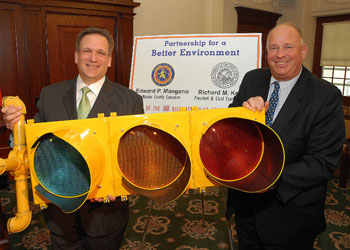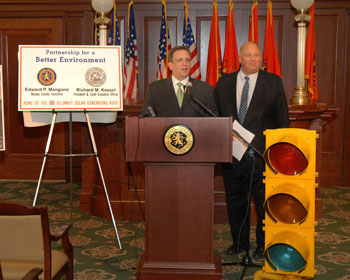New York Power Authority and Nassau County Announce Partnership, Including Solar Photovoltaic Installation and LED Traffic Signals

Mineola, NY—New York Power Authority (NYPA) President and Chief Executive Officer Richard M. Kessel today joined Nassau County Executive Edward P. Mangano to announce a partnershipto save taxpayer money by lowering energy costs through energy efficiency and clean energy projects. The first project will be to install an 80 kilowatt solar photovoltaic (PV) project at Nassau County Public Safety Center.
The project, which NYPA will lower greenhouse gas emissions by 46.8 tons or 93,548 pounds annually, diversify the county’s energy supply, and contribute to energy security.
“This is an exciting beginning to a journey to make Nassau County more efficient and energy independent,” said Mangano. “It will save taxpayer dollars and help lower power plant emissions.”
“NYPA is deeply committed to helping New York improve its energy independence and reduce its energy costs through projects such as these,” Kessel said. “I commend County Executive Mangano for his leadership and dedication in joining in this partnership and in the effort to advance clean energy initiatives that will both lower energy costs and help protect the environment for Nassau County residents.”
NYPA also has agreed to provide an $812,000 grant in support of a partnership between Nassau County and the Power Authority for the installation of energy efficient lighting technology in county-owned traffic signals at more than 1,300 intersections located throughout the county.
Installation efforts should begin on the $8.75 million project early this summer and is expected to take eight to 12 months to complete, weather-permitting. The installations are among the first in all of Nassau County as part of NYPA’s LED (light-emitting diode) Traffic Signal Program.
Taxpayer savings for county residents—because of the lower electric use of the LED traffic signals—is estimated to be almost $1.1 million annually. The new signals are expected to last more than 10 years allowing for more efficient use of resources that will save on replacement, maintenance and disposal costs. Additionally, the LED modules are larger in diameter and much brighter than standard bulbs, which will improve driver and pedestrian safety. County Executive Mangano stated that these new traffic signals are "Safer, Lighter, and Brighter."
 In addition to these projects, NYPA has committed to working with Nassau County as it implements a new program to provide low-cost financing to homeowners undertaking energy efficiency projects.
In addition to these projects, NYPA has committed to working with Nassau County as it implements a new program to provide low-cost financing to homeowners undertaking energy efficiency projects.
Many public facilities in Nassau County where NYPA has undertaken Energy Services Program projects include schools in Bellmore, Bethpage, Carle Place, Great Neck, Hicksville, Levittown, Manhasset, New Hyde Park/Garden City, Roslyn, Valley Stream, and many others. Village facilities have included Floral Park, Garden City and Valley Stream.
NYPA has a long history of developing and implementing energy efficiency projects within Nassau County, dating back to 1992. As of the end of 2009, almost 70 projects at more than 180 facilities have been completed within Nassau County, saving taxpayers more than $6 million a year and removing more than 30,000 tons of greenhouse gases from the air.
NYPA and Nassau County have partnered on numerous projects since 1997. Together, NYPA and Nassau County have completed efficiency projects a variety of Nassau County facilities, including: Nassau County Community College, the Cedar Creek Waste Water Treatment Plant, the Nassau County Courthouse, and the Nassau County Family Court and Supreme Court Buildings.
NYPA is the nation’s largest state-owned electric utility and uses no taxpayer dollars or state debt in its operations. The Power Authority owns and operates 17 generating facilities across New York. NYPA also owns and operates over 1,400 circuit miles of transmission lines in various parts of the state. NYPA is a national leader in advancing energy efficiency, clean energy technologies and electric vehicles.

